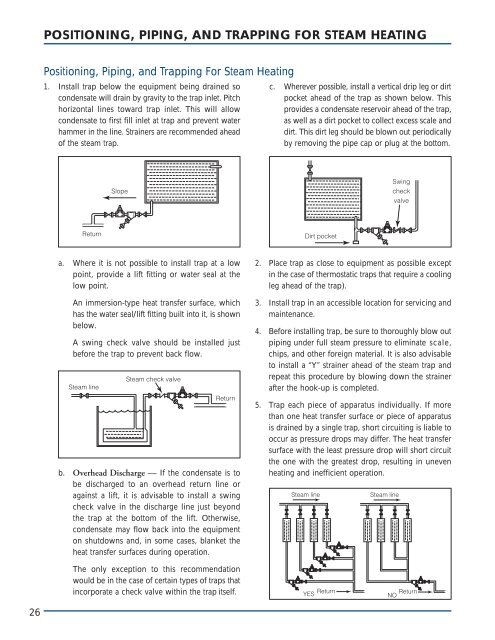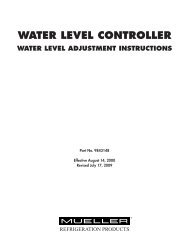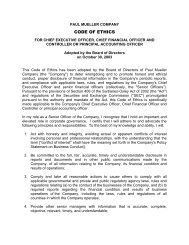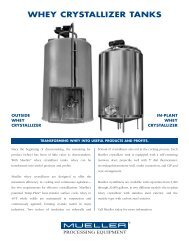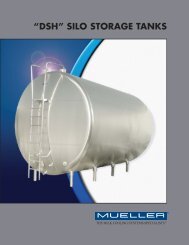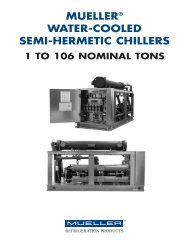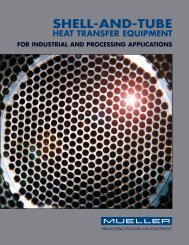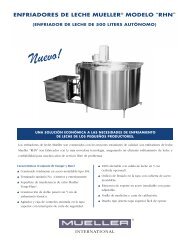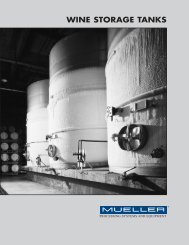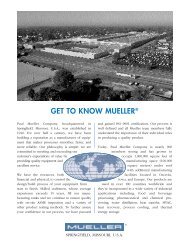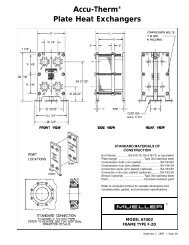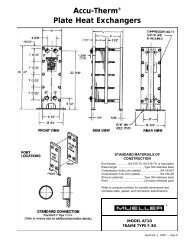ALL ABOUT TEMP-PLATE® - Paul Mueller Company
ALL ABOUT TEMP-PLATE® - Paul Mueller Company
ALL ABOUT TEMP-PLATE® - Paul Mueller Company
You also want an ePaper? Increase the reach of your titles
YUMPU automatically turns print PDFs into web optimized ePapers that Google loves.
26<br />
POSITIONING, PIPING, AND TRAPPING FOR STEAM HEATING<br />
Positioning, Piping, and Trapping For Steam Heating<br />
1. Install trap below the equipment being drained so<br />
condensate will drain by gravity to the trap inlet. Pitch<br />
horizontal lines toward trap inlet. This will allow<br />
condensate to first fill inlet at trap and prevent water<br />
hammer in the line. Strainers are recommended ahead<br />
of the steam trap.<br />
Return<br />
a. Where it is not possible to install trap at a low<br />
point, provide a lift fitting or water seal at the<br />
low point.<br />
An immersion-type heat transfer surface, which<br />
has the water seal/lift fitting built into it, is shown<br />
below.<br />
A swing check valve should be installed just<br />
before the trap to prevent back flow.<br />
Steam line<br />
Slope<br />
Steam check valve<br />
Return<br />
b. Overhead Discharge — If the condensate is to<br />
be discharged to an overhead return line or<br />
against a lift, it is advisable to install a swing<br />
check valve in the discharge line just beyond<br />
the trap at the bottom of the lift. Otherwise,<br />
condensate may flow back into the equipment<br />
on shutdowns and, in some cases, blanket the<br />
heat transfer surfaces during operation.<br />
The only exception to this recommendation<br />
would be in the case of certain types of traps that<br />
incorporate a check valve within the trap itself.<br />
c. Wherever possible, install a vertical drip leg or dirt<br />
pocket ahead of the trap as shown below. This<br />
provides a condensate reservoir ahead of the trap,<br />
as well as a dirt pocket to collect excess scale and<br />
dirt. This dirt leg should be blown out periodically<br />
by removing the pipe cap or plug at the bottom.<br />
Dirt pocket<br />
Swing<br />
check<br />
valve<br />
2. Place trap as close to equipment as possible except<br />
in the case of thermostatic traps that require a cooling<br />
leg ahead of the trap).<br />
3. Install trap in an accessible location for servicing and<br />
maintenance.<br />
4. Before installing trap, be sure to thoroughly blow out<br />
piping under full steam pressure to eliminate scale,<br />
chips, and other foreign material. It is also advisable<br />
to install a “Y” strainer ahead of the steam trap and<br />
repeat this procedure by blowing down the strainer<br />
after the hook-up is completed.<br />
5. Trap each piece of apparatus individually. If more<br />
than one heat transfer surface or piece of apparatus<br />
is drained by a single trap, short circuiting is liable to<br />
occur as pressure drops may differ. The heat transfer<br />
surface with the least pressure drop will short circuit<br />
the one with the greatest drop, resulting in uneven<br />
heating and inefficient operation.<br />
Steam line<br />
Steam line<br />
YES<br />
Return<br />
Return<br />
NO


